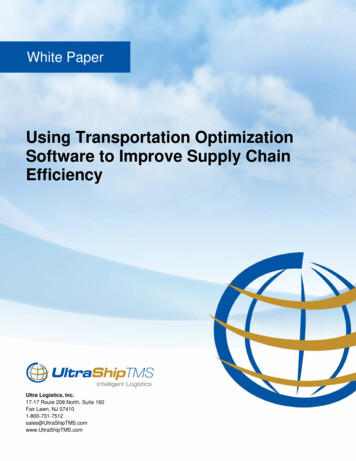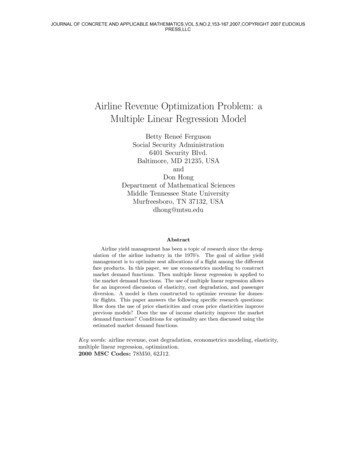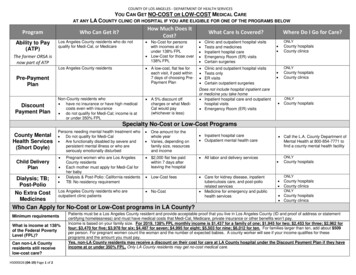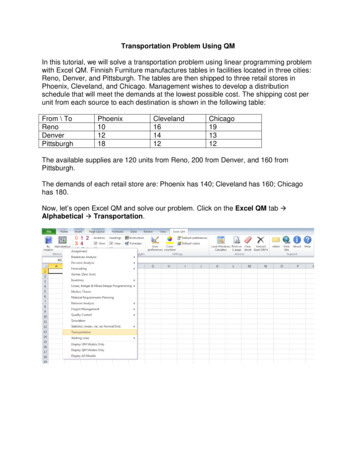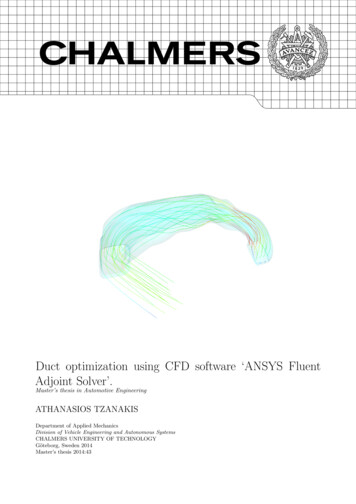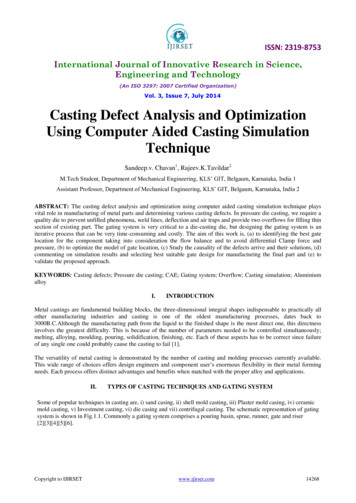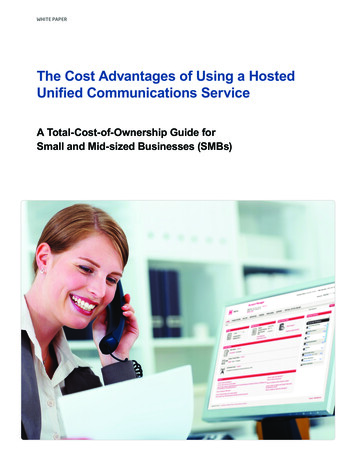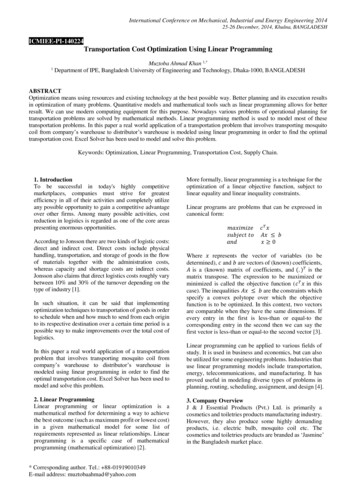
Transcription
International Conference on Mechanical, Industrial and Energy Engineering 201425-26 December, 2014, Khulna, BANGLADESHICMIEE-PI-140224Transportation Cost Optimization Using Linear Programming1Muztoba Ahmad Khan 1,*Department of IPE, Bangladesh University of Engineering and Technology, Dhaka-1000, BANGLADESHABSTRACTOptimization means using resources and existing technology at the best possible way. Better planning and its execution resultsin optimization of many problems. Quantitative models and mathematical tools such as linear programming allows for betterresult. We can use modern computing equipment for this purpose. Nowadays various problems of operational planning fortransportation problems are solved by mathematical methods. Linear programming method is used to model most of thesetransportation problems. In this paper a real world application of a transportation problem that involves transporting mosquitocoil from company’s warehouse to distributor’s warehouse is modeled using linear programming in order to find the optimaltransportation cost. Excel Solver has been used to model and solve this problem.Keywords: Optimization, Linear Programming, Transportation Cost, Supply Chain.1. IntroductionTo be successful in today's highly competitivemarketplaces, companies must strive for greatestefficiency in all of their activities and completely utilizeany possible opportunity to gain a competitive advantageover other firms. Among many possible activities, costreduction in logistics is regarded as one of the core areaspresenting enormous opportunities.According to Jonsson there are two kinds of logistic costs:direct and indirect cost. Direct costs include physicalhandling, transportation, and storage of goods in the flowof materials together with the administration costs,whereas capacity and shortage costs are indirect costs.Jonsson also claims that direct logistics costs roughly varybetween 10% and 30% of the turnover depending on thetype of industry [1].In such situation, it can be said that implementingoptimization techniques to transportation of goods in orderto schedule when and how much to send from each originto its respective destination over a certain time period is apossible way to make improvements over the total cost oflogistics.More formally, linear programming is a technique for theoptimization of a linear objective function, subject tolinear equality and linear inequality constraints.Linear programs are problems that can be expressed incanonical ���𝑒𝑐𝑡 𝑡𝑜𝑎𝑛𝑑𝑐𝑇 𝑥𝐴𝑥 𝑏𝑥 0Where 𝑥 represents the vector of variables (to bedetermined), 𝑐 and 𝑏 are vectors of (known) coefficients,𝐴 is a (known) matrix of coefficients, and (. )𝑇 is thematrix transpose. The expression to be maximized orminimized is called the objective function (𝑐 𝑇 𝑥 in thiscase). The inequalities 𝐴𝑥 𝑏 are the constraints whichspecify a convex polytope over which the objectivefunction is to be optimized. In this context, two vectorsare comparable when they have the same dimensions. Ifevery entry in the first is less-than or equal-to thecorresponding entry in the second then we can say thefirst vector is less-than or equal-to the second vector [3].In this paper a real world application of a transportationproblem that involves transporting mosquito coil fromcompany’s warehouse to distributor’s warehouse ismodeled using linear programming in order to find theoptimal transportation cost. Excel Solver has been used tomodel and solve this problem.Linear programming can be applied to various fields ofstudy. It is used in business and economics, but can alsobe utilized for some engineering problems. Industries thatuse linear programming models include transportation,energy, telecommunications, and manufacturing. It hasproved useful in modeling diverse types of problems inplanning, routing, scheduling, assignment, and design [4].2. Linear ProgrammingLinear programming or linear optimization is amathematical method for determining a way to achievethe best outcome (such as maximum profit or lowest cost)in a given mathematical model for some list ofrequirements represented as linear relationships. Linearprogramming is a specific case of mathematicalprogramming (mathematical optimization) [2].3. Company OverviewJ & J Essential Products (Pvt.) Ltd. is primarily acosmetics and toiletries products manufacturing industry.However, they also produce some highly demandingproducts, i.e. electric bulb, mosquito coil etc. Thecosmetics and toiletries products are branded as ‘Jasmine’in the Bangladesh market place.* Corresponding author. Tel.: 88-01919010349E-mail address: muztobaahmad@yahoo.com
2.1 About the FactoryThe factory [5] is located at BSCIC industrial area,Golora, Manikganj, Bangladesh. It has one 5 storiedbuilding (main factory building) of 35000 sq. ft., eachfloor area covering 7000 sq. ft.2.2 Marketing & Distribution of mosquito coil:The Company has set up regional offices in Dhaka,Chittagong and Bogra along with warehouse facilities.There are seven distributor’s warehouses where thegoods are delivered from company’s warehouses. Thecompany sends goods through four of its own vehiclesand use public transport services. The company’s salesand distribution costs account for 19% of total cost.4. Problem StatementSince the optimization model that will be developed isexpected to be applicable to different instances, thissection starts with depicting the scope of the problemwhich is followed by an extended description of theproblem through a case provided by the company.Storage capacity: Storage capacity of company’sdifferent warehouses:Table 2 Average shipping costs of per carton coil.Dhaka3980Chittagong1785Bogra4856*All units are in cartonsDemands: Average demand of different distributor’swarehouses:Table 3 Average shipping costs of per carton ajshahi1658Sylhet2035Khulna1159*All units are in cartonsThe problem is to determine the optimal quantity ofmosquito coil that should be delivered from company’seach warehouse to different distributor’s warehouse inorder to obtain the minimum transportation cost.The company delivers mosquito coils from its threewarehouses in Dhaka, Chittagong and Bogra to sevendistributor’s warehouses in Barisal, Chittagong, Dhaka,Rajshahi, Rangpur, Sylhet and Khulna withoutconsidering the optimal quantity. So if the companyapplies linear programming to find the optimal quantityof mosquito coil to be delivered, it will be able tominimize the transportation cost significantly, which willresult in increased profitability.Fig.1 Illustration of the transportation network.In order to determine the optimal quantity of mosquitocoil that should be delivered from company’s eachwarehouse to different distributor’s warehouse forobtaining the minimum transportation cost, the followinginformation were collected from the Supply ChainDirector of the company:5. Mathematical Model FormulationFor the given problem, we formulate a mathematicaldescription called a mathematical model to represent thesituation. The model consists of following components:Shipping cost: Average shipping costs of per cartonmosquito coil from company’s warehouse to differentdistributor’s warehouse are given in the table below:Decision variables: These variables represent unknownquantities (number of items to produce, amounts ofmoney to invest in and so on).Table 1 Average shipping costs of per carton coil.Objective function: The objective of the problem isexpressed as a mathematical expression in decisionvariables. The objective may be maximizing the profit,minimizing the cost, distance, time, et125427204Khulna215375160*All units are in Bangladesh Taka (BDT)Constraints: The limitations or requirements of theproblem are expressed as inequalities or equations indecision variables [6].ICMIEE-PI-140224- 2
Followings are the decision variables, objective functionand constraints specific to the problem of this paper:Decision variables:Three warehouses will be symbolized as:Dhaka A1Chittagong A2Bogra A3The quantity of mosquito coils sent from Ai is 7𝑗 1 𝑋(𝑖, 𝑗) and since the quantity of mosquito coilsavailable at Ai is ai, we must have 7𝑗 1 𝑋(𝑖, 𝑗) 𝑎(𝑖), 𝑤ℎ𝑒𝑟𝑒 𝑖 1, 2 𝑎𝑛𝑑 3.Now, the quantity of mosquito coils sent to B j is 3𝑖 1 𝑋(𝑖, 𝑗) and since the quantity of mosquito coilsrequired at Bj is bj, we must have 3𝑖 1 𝑋(𝑖, 𝑗) 𝑏(𝑗), 𝑤ℎ𝑒𝑟𝑒 𝑗 1, 2, 4, 5, 6 𝑎𝑛𝑑 7.Seven distributor’s warehouses will be symbolized as:Dhaka B1Chittagong B2Rangpur B3Barisal B4Rajshahi B5Sylhet B6Khulna B7Let the storage capacity of mosquito coils at Ai be ai;where i 1, 2 and 3.Let the requirements of mosquito coils at B j be bj; wherej 1, 2, 3, 4, 5, 6 and 7.Let Cij be the cost of shipping one carton mosquito coilfrom Ai to Bj.Let Xij be the number of cartons of coil shipped from Aito Bj.Now let’s assign the respective variables in Table 1:It is assumed that we cannot send a negative quantityfrom Ai to Bj, so Xij 0 for all values of i and j.6. Modeling the Problem using Excel SolverThis section will demonstrate, how to use Excel Solverto find the optimum transportation cost.The first step is to organize the spreadsheet to representthe model. Once the model is implemented in aspreadsheet, next step is to use the Solver to find thesolution. In the Solver, we need to identify the locations(cells) of objective function, decision variables, nature ofthe objective function (maximize/minimize) andconstraints.Step by step solution of the problem using Excel Solveris given below:Step 1:At first we will construct a table in excel that will containthe cost parameters between each destination.Table 4 Average shipping costs with assigned ouseDhaka (B1)Chittagong (B2)Rangpur (B3)Barisal (B4)Rajshahi (B5)Sylhet (B6)Khulna (B7)RequirementDhakaA1C2,1 15C1,2 160C1,3 154C1,4 245C1,5 130C1,6 125C1,7 215a1 3980ChittagongA2C2,1 160C2,2 12C2,3 315C2,4 410C2,5 290C2,6 427C2,7 375a2 1785BograA3StockC3,1 100C3,2 260C3,3 56C3,4 190C3,5 58C3,6 204C3,7 160a3 4856b1 1168b2 1560b3 1439b4 986b5 1658b6 2035b7 1159Step 2:Now we will construct another table that will containshipment, stock and requirements.Objective function:The objective function contains costs associated witheach of the variables. It is a minimization problem.37𝑀𝑖𝑛𝑖𝑚𝑖𝑧𝑒 𝑓 𝐶 (𝑖, 𝑗) 𝑋(𝑖, 𝑗)𝑖 1 𝑗 1Here “Total In” is the quantity of coils shipped to thatparticular distributor’s warehouse from company’s threewarehouses.Constraints:i.e. for Dhaka it is “ SUM(I7:I9)”The constraints are the conditions that force supply anddemand needs to be satisfied. In the transportationproblem, there is one constraint for each node.And “Total Out” is the quantity of coils shipped from thatparticular warehouse to distributor’s seven warehouses.i.e. for Dhaka it is “ SUM(I7:O7)”ICMIEE-PI-140224- 3
Step 3:Now we will create a cell that will automatically calculatetotal cost based on the inputs in shipment table.Step 6:Now we will add constrains of this problem in Solver. Aspreviously discussed, there are three constrains in thisproblem:(1) Total Out is less than or equal to Stock(2) Total In is equal to Requirement(3) Shipment quantities are non-negativeTo calculate total cost we need the functionSUMPRODUCT. This function will automatically sumall the product of unit and cost per unit.To add constrains we will click add button on Solver andlocate each constrains.(1) Total Out is less than or equal to Stock ( P 7: P 9 R 7: R 9)i.e. Total Cost SUMPRODUCT(J18:P20,I7:O9)Step 4:In this step we will setup Excel Solver according to thisproblem. First we will open Solver from Data tab andlocate the Total Minimum Cost cell in to ‘Set Objective’in solver (i.e. U 13). As we want to minimize thefunction we will choose ‘Min’. Also we will choose oursolving method as ‘Simplex LP’.(2) Total In is equal to Requirement ( I 10: O 10 I 12: O 12)(3) Shipment quantities are non-negative (we will justselect ‘Make Unconstrained Variables Nonnegative’)Step 5:In this step we will locate the changing variables (i.e. theoptimal quantities) in to ‘By Changing Variable Cells:’option of Solver.Here changing cells will be I 7: O 9ICMIEE-PI-140224- 4
Step 7:Now we are done with the setup, all that is left is to clickon ‘Solve’ button. This way we will find the followingsolution from Solver:7. ConclusionThough this model has some limitations, still if thecompany applies the solution reached through this study,it will be able to minimize the transportation cost, whichwill result in increased profitability. In future a moreoptimized model of this problem can be developed bygetting rid of the limitations mentioned above.But again, certainly there will be some real life constrains,which we won’t be able to solve with any model. In thosecases we will have to depend on our intuition andexperience.REFERENCES[1] P. Jonsson, Logistics and supply chain management.McGraw-Hill, (2008).[2] Wikipedia.org, (August, 2014). Linear programming,Available from: http://en.wikipedia.org/wiki/Linearprogramming, [Accessed 15 August 2014].[3] S. A. Phatangare, R. A. Deshmukh, P. K. Deshmukh,Public Cryptography Linear and Non LinearProgramming Solver in Cloud Computing,International Journal of Application or Innovationin Engineering & Management (IJAIEM), Vol. 2, pp141-145, (2013).[4] I. S. Fagoyinbo, R. Y. Akinbo, I. A. Ajibode, Y. O. A.Olaniran, Maximization of profit in manufacturingindustries using linear programming techniques:Geepee Nigeria Limited, Mediterranean Journal ofSocial Sciences, Vol. 2, pp 97-105 (2011).[5] J & J Essential Products (Pvt.) Ltd, CompanyOverview 2013, (2013).[6] L. Chandrakantha, Using Excel Solver inOptimization problems, Mathematics and ComputerScience Department, New York (2008).7. LimitationsIn this problem we considered that supply will alwaysexceed the demand. But in reality shortage of supply canexist.Another importation limitation is that the companyallocated 150 taka per carton for transportation cost whensetting the trade price of their coil. So if the companymakes a shipment that costs more than 150 taka percarton, it may incur loss.ICMIEE-PI-140224- 5
modeled using linear programming in order to find the optimal transportation cost. Excel Solver has been used to model and solve this problem. 2. Linear Programming Linear programming or linear optimization is a mathematical method for determining a way to achieve
